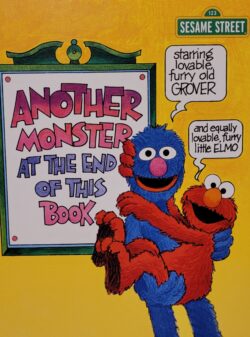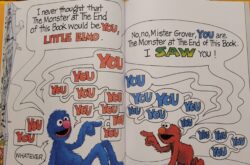It’s been over a decade now, maybe more, since we discovered an inner dimension and deeper meaning to Sesame Street’s classic “There’s a Monster at the End of This Book.” Some years we share it on Yom Kippur (it’s alumnus Ari B.’s favorite sermon of mine!) that we fear all the turning pages of the Machzor, but the journey of Yom Kippur allows us to re-discover ourselves, indeed, we are the Monster at the End of the Book, but we don’t fear that outcome anymore.
 But this week our daughter Chani was in Kohl’s doing some returns and she saw that there’s a sequel! The original book was first published in 1971, written by Jon Stone. This sequel was written by the same Jon Stone for Sesame Street in 1996 – 25 years after the first book. This behooves us to do a closer read and take a look and see what life messages lie therein, and in what ways is the second book different than the first, with new ideas for us to explore and connect with.
But this week our daughter Chani was in Kohl’s doing some returns and she saw that there’s a sequel! The original book was first published in 1971, written by Jon Stone. This sequel was written by the same Jon Stone for Sesame Street in 1996 – 25 years after the first book. This behooves us to do a closer read and take a look and see what life messages lie therein, and in what ways is the second book different than the first, with new ideas for us to explore and connect with.
The basic plot is the same. Grover is terrified of the book’s title, he’s worried about what type of ferocious monster may be lurking at the back of the book. So he’d rather not turn any pages, no reason to get any closer to monsters like that. Grover puts up all types of obstacles and blockages to try and ensure (unsuccessfully) that the pages are not turned. Those parts are the same.
But here’s where it differs. In the original book, Grover builds all types of blockages and resistance, and it is the reader (external to the book, not a character in the story) who turns the pages anyways. The sequel has Elmo doing that part. From the get-go, from page 1, Elmo is eager to go turn pages to find the monster at the end of the book. Elmo is the one who ignores Grover’s anxieties and entreaties and turns the pages (or sneaks over to the next one) and pulls down any resistance or obstacle that Grover puts up.
My first thought was that it recalls Tanya’s “two souls”. The Alter Rebbe’s classic Tanya teaching that we are composite human beings composed of two (often opposing) drives, two operating systems operating simultaneously within us. Unlike the original book where this is an outside external force, both characters are within our book, within our person. In this case, we are both Elmo and Grover.
 Let’s get a little more into specifically the Elmo vs. Grover part.
Let’s get a little more into specifically the Elmo vs. Grover part.
(At least in this book) Elmo is fearless, Grover is fearful. Grover is more the cautious and careful type, Elmo is being carefree and curious. Grover is happier with the known and comfortable status-quo, Elmo is eager to push the limits, test the unknown and discover new horizons.
At the end of the book, they are surprised to find each other – and each one claims the other is the monster!
We the reader know that both of them are the monsters at the end of the book! Indeed, as the title itself suggests: “ANOTHER Monster at the End of This Book.” Both, and specifically both together, in balance and in synchronized unison, are the idealized conclusion. Not one or the other.
Life is usually a balance, for most things. There’s a time and place to be more cautious. But too much caution isn’t good either, there’s much opportunity that can be lost if we aren’t curious enough or willing to take risks. But living on the edge can be precarious and dangerous, its helpful to also be careful, cautious and responsible.
— May try to develop this a bit further, but this is what we came up with on Shabbos.
